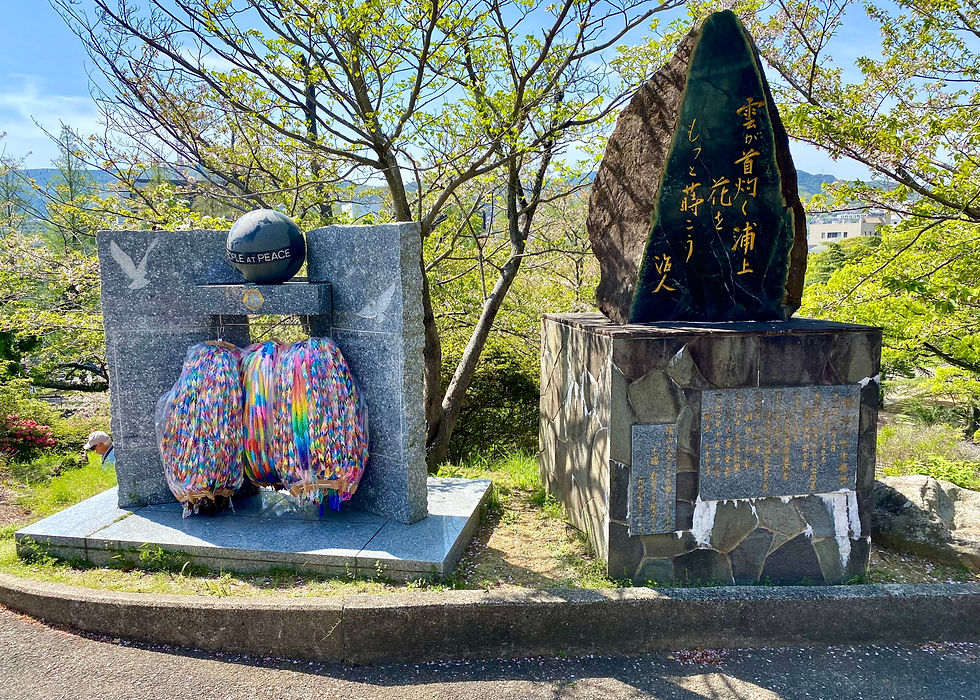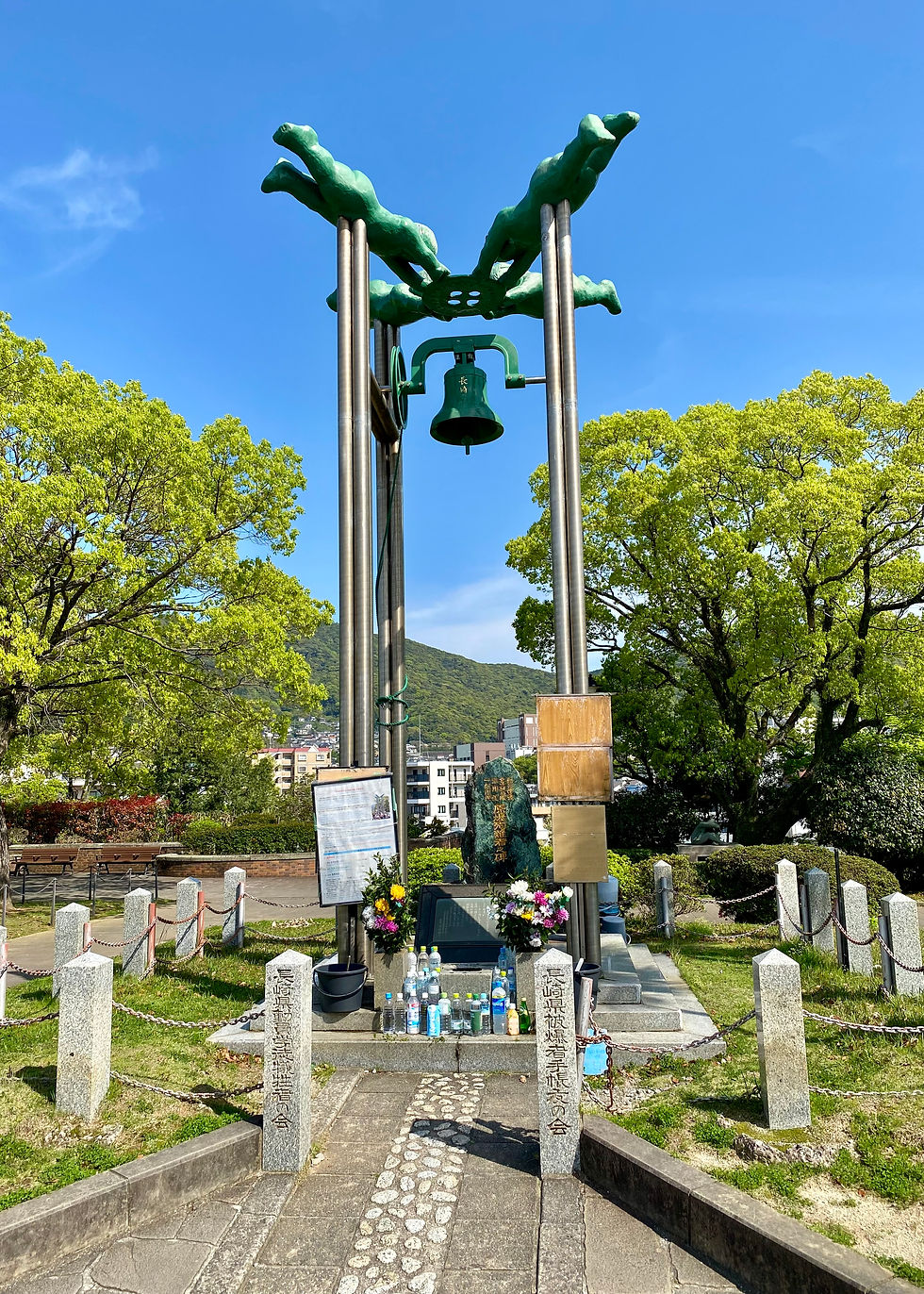April 10, 2024–Nagasaki, Japan
- mlchad147
- Apr 10, 2024
- 4 min read

No fun selfies today. I’m sure there are a lot of entertaining things to do in this vibrant city of 440,000, but with only one day in port our priority was to visit the site where the US detonated the second atomic bomb on the Japanese home islands in 1945.
We docked mid morning and were blessed with perfect weather—bright sunshine, low humidity, and temperatures in the mid to upper 60s. The air was crisp and clear, a dramatic change from the constant haze and smog we experienced during our two days in China. The difference was much appreciated, since a good bit of our scheduled excursion involved walking outside.
Our first stop, though, was an inside job, as we toured the Nagasaki Atomic Bomb Museum. You can probably guess what many of the exhibits look like, so I won’t go into great detail here. I will post some photos below, so be sure to check them out. What I do want to mention, and what I found uplifting, is the recurrent theme of peace, and the urgency of the message that this must never happen again.
One interesting thing that we noticed was the strings of brightly colored origami cranes on display in several areas, both inside and outside the museum. Cranes are considered to be symbolic of longevity and happiness in Japan, and making a thousand of them in one’s lifetime is significant. The strings of cranes were donated by individuals to honor the victims of the atomic blast, and their bright colors stood in sharp contrast to the darker displays showing the bomb’s impact on the city.
The museum sits just uphill from our next destination, the Nagasaki Peace Park and Ground Zero, and while it’s an easy walk we were transported part of the way down the hill by bus. From where the bus dropped us off it’s still a good deal further downhill to the Peace Park, and I found it interesting that the city has installed two long outdoor escalators to aide visitors who wish to avoid the steps.
The Peace Park is a large, mostly open and grassy, and has several monuments along the side honoring the victims, many of which were gifts from other countries, including Brazil, Cuba, Argentina and the US. Interestingly, St. Paul, Minnesota is Nagasaki’s sister city, and one of the monuments was a gift from the Minnesota city’s residents.
However, the park is dominated by two larger and more significant monuments. At one end of the park is the 32 foot tall Peace Statue, erected by the citizens of Nagasaki in 1955 to mark the tenth anniversary of the bombing. The statue is of a man whose right hand points skyward to symbolize the danger of nuclear weapons, while his left hand is extended outward to symbolize eternal peace. His eyes are closed in prayer for the victims. The overall effect was very powerful, at least for me, and I was disappointed to see a few of our ship’s passengers taking selfies and imitating the statue’s gestures with great amusement.
At the other end of the park is Ground Zero, the spot where 500 meters directly overhead the bomb detonated. The spot is marked by a simple black column, with a black vault at its base. A sign on the vault indicates the number of victims of the blast, a number that continues to be updated every year. Currently the number of dead stands at 195,607, a staggering testament to man’s ability to kill his fellow man.
We made a slow walk back through the park, stopping frequently to inspect the smaller monuments referenced above, and then took advantage of the two long escalators to climb back up to the parking lot where our bus awaited. From there it was a thirty minute ride back to the ship through busy city traffic, and the end of our somber visit to one of the planet’s most important historical sites.
I’ll end on an upbeat note. As with Okinawa, it was uplifting to see how well the city has recovered, and if not for the Atomic Bomb Museum and Peace Park you might never know what happened here in 1945. Hopefully Nagasaki will always be remembered as the last place where nuclear weapons were used by one country against another.
That’s it for now. Tomorrow we’re in Kagoshima, an intriguing city lying at the base of an active volcano. Should be interesting, so stay tuned.

Monument outside the entrance to the Nagasaki Atomic Bomb Museum

Clock recovered after the blast, displaying the exact time the bomb detonated.

Recreation of a church front at Ground Zero.

Closeup of the recreated church front. Not this much actually survived the blast. One column did, and it still stands. Photo below.

Actual size mock-up of the bomb.

Uniforms recovered from somewhat farther away from Ground Zero.

Melted bottles.

These are chains of origami cranes displayed in the museum. They symbolize longevity and happiness, hope for the future.

The massive Peace Statue dominates one end of Peace Park. The statue alone, not counting the stone pedestal, is 32 feet tall.

Another monument at the Peace Park.

This foundation is all that was left of a jail near Ground Zero. All the guards and prisoners died instantly.

Another monument at the Peace Park.
This bell is rung at 2:00 pm every day.

There’s a nice fountain in the Park. Note the Peace Statue in the background.

The Park is beautifully landscaped.

The simple monument at Ground Zero. The number of dead is updated annually on the vault.

This is the actual column of the church that survived the blast. It’s just a short walk away from Ground Zero.

Two stone lanterns were all that survived from a temple 1.5 kilometers from Ground Zero. The lanterns were brought to the Park several years later.

This monument was donated by the United States, and is one of several in the Peace Park donated by foreign countries.

This monument was donated by China.

Chains of cranes hanging from one of the monuments in the Park.

Okay, one smiling photo to end on a sunnier note. I’m always happy to find a Coke in a glass bottle. It just tastes better.



